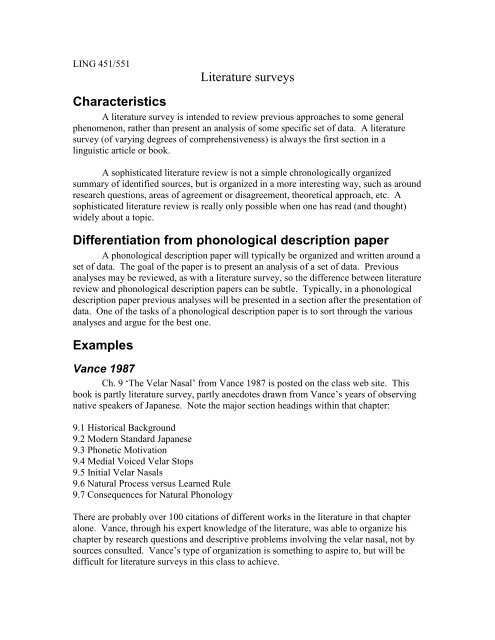Additional guidelines for literature reviews
Additional guidelines for literature reviews
Additional guidelines for literature reviews
You also want an ePaper? Increase the reach of your titles
YUMPU automatically turns print PDFs into web optimized ePapers that Google loves.
LING 451/551<br />
Literature surveys<br />
Characteristics<br />
A <strong>literature</strong> survey is intended to review previous approaches to some general<br />
phenomenon, rather than present an analysis of some specific set of data. A <strong>literature</strong><br />
survey (of varying degrees of comprehensiveness) is always the first section in a<br />
linguistic article or book.<br />
A sophisticated <strong>literature</strong> review is not a simple chronologically organized<br />
summary of identified sources, but is organized in a more interesting way, such as around<br />
research questions, areas of agreement or disagreement, theoretical approach, etc. A<br />
sophisticated <strong>literature</strong> review is really only possible when one has read (and thought)<br />
widely about a topic.<br />
Differentiation from phonological description paper<br />
A phonological description paper will typically be organized and written around a<br />
set of data. The goal of the paper is to present an analysis of a set of data. Previous<br />
analyses may be reviewed, as with a <strong>literature</strong> survey, so the difference between <strong>literature</strong><br />
review and phonological description papers can be subtle. Typically, in a phonological<br />
description paper previous analyses will be presented in a section after the presentation of<br />
data. One of the tasks of a phonological description paper is to sort through the various<br />
analyses and argue <strong>for</strong> the best one.<br />
Examples<br />
Vance 1987<br />
Ch. 9 ‘The Velar Nasal’ from Vance 1987 is posted on the class web site. This<br />
book is partly <strong>literature</strong> survey, partly anecdotes drawn from Vance’s years of observing<br />
native speakers of Japanese. Note the major section headings within that chapter:<br />
9.1 Historical Background<br />
9.2 Modern Standard Japanese<br />
9.3 Phonetic Motivation<br />
9.4 Medial Voiced Velar Stops<br />
9.5 Initial Velar Nasals<br />
9.6 Natural Process versus Learned Rule<br />
9.7 Consequences <strong>for</strong> Natural Phonology<br />
There are probably over 100 citations of different works in the <strong>literature</strong> in that chapter<br />
alone. Vance, through his expert knowledge of the <strong>literature</strong>, was able to organize his<br />
chapter by research questions and descriptive problems involving the velar nasal, not by<br />
sources consulted. Vance’s type of organization is something to aspire to, but will be<br />
difficult <strong>for</strong> <strong>literature</strong> surveys in this class to achieve.
Hargus 2010<br />
Hargus 2010 is a short article summarizing the then-current state of research in<br />
Athabaskan phonetics and phonology. The intended audience <strong>for</strong> my article is a faculty<br />
member or graduate student thinking about embarking on research in Athabaskan<br />
phonetics or phonology. I organized the article around subareas of phonetics or<br />
phonology that have received attention in the <strong>literature</strong>:<br />
1 Overview<br />
2 Morphology<br />
3 Diachronic studies<br />
4 Phonetic studies<br />
5 Non-instrumental phonological studies<br />
6 Suprasegmental phonology<br />
7 Sentence-level phonology<br />
8 Contact phonology<br />
9 Phonological acquisition<br />
10 Phonological consequences of language loss<br />
11 Future directions<br />
Caveat<br />
From the mid 1990s on, phonological analyses have generally been written in<br />
terms of Optimality Theory, a phonological theory not introduced until LING 452. This<br />
framework uses constraint, not rules, to describe phonological phenomena. When you<br />
come across a source which uses this framework, your review of this <strong>literature</strong> should<br />
emphasize new empirical (data-driven) insights offered by the analyst, not new <strong>for</strong>mal<br />
analytical techniques. A paper written <strong>for</strong> this class should not contain lists of<br />
constraints, constraint rankings, or tableaux---save that <strong>for</strong> 452. If the only insight by the<br />
recent <strong>literature</strong> is <strong>for</strong>mal, then make an appointment to talk to me about the best way to<br />
present this in your paper.<br />
<strong>Additional</strong> <strong>guidelines</strong> <strong>for</strong> <strong>literature</strong> <strong>reviews</strong><br />
The Blackwell-Compass web site has some valuable suggestions <strong>for</strong> authors of<br />
review articles:<br />
http://www.blackwell-compass.com/author_centre<br />
References<br />
Hargus, Sharon. 2010. 'Athabaskan Phonetics and Phonology.' Language and Linguistics<br />
Compass 3/1:1-22.<br />
Vance, Timothy J. 1987. An Introduction to Japanese Phonology. Albany: SUNY Press.

















